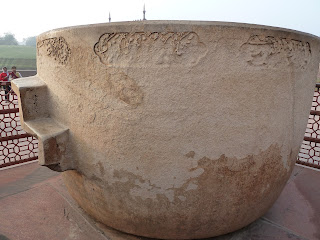part 5 of ...
~ ~ ~
Red Fort of Agra
(UNESCO World Heritage Site)
Tomb of John Russell Colvin - governor during the British occupation of India.
He loved Mughal architecture and wanted to be buried here.
~ ~ ~ ~ ~ ~ ~ ~ ~ ~ ~ ~ ~ ~ ~ ~ ~ ~ ~ ~ ~ ~ ~ ~ ~ ~ ~ ~ ~ ~ ~ ~ ~ ~ ~ ~ ~ ~
UTTAR PRADESH
Sikandra
Akbar himself picked this location for the construction of his tomb. He died before it was completed, but his son, Jahangir, completed the building. The mausoleum of the Emperor Akbar was built from 1605-1613, before the Taj Mahal.
Each side of the wall has it's own gate - this is the south entrance. Notice the four white marble minarets. There are also four domed chhatri pavillions at the top that can't be seen from this angle. A closer look at the south entrance will enable you to see Kilim designs, arabesque geometric patterns, Arabic calligraphy, and floral motifs.
(left) The calligraphy admist the colorful floral patterns was written and designed by a famous calligrapher of Mughal monuments Abd al- Haqq Shirazi (later known as Amanat Khan). He also wrote the inscriptions found on the Taj Mahal. (right) An example of jali, stone that is perforated in a geometric and ornamental pattern.
(left) tomb ceiling, (right) in front of Akbar's cenotaph
~ ~ ~
About Akbar
~ ~ ~
About Akbar
Akbar is known for being a great ruler. He the third Mughal Emperor, who ascended to the throne at age fourteen, after the death of his father, Humayun.
He was said to be a very religiously tolerant man, doing the unheard of - marrying wives of different religions, Christian, Hindu, and Muslim. (Fyi, he had a total of 36 wives and harem of 300+ women.)
He did try to start his own religion, Din-i-ilahi, which was supposed to take the best out parts out of all the religions in his empire. Din-i-ilahi died out shortly after his death.
He is known to be a wise man; by the end of his reign, he was one of the most powerful emperors in India.
He was said to be a very religiously tolerant man, doing the unheard of - marrying wives of different religions, Christian, Hindu, and Muslim. (Fyi, he had a total of 36 wives and harem of 300+ women.)
He did try to start his own religion, Din-i-ilahi, which was supposed to take the best out parts out of all the religions in his empire. Din-i-ilahi died out shortly after his death.
He is known to be a wise man; by the end of his reign, he was one of the most powerful emperors in India.
~ ~ ~
Red Fort of Agra
(UNESCO World Heritage Site)
Our guide during our stay in Agra. He was one of our favorite guides.
Nice, informative, and not pushy or demanding.
It was cold, and the air was bothering me (it was really foggy),
so I bought a scarf, which I wore it in this manner. I look like a turtle. ;)
Agra fort has a long history, but was in it's full glory under Akbar, when he arrived in 1558. He renovated much of the building which was formerly made of brick, with red sandstone. Akbar's grandson, Shah Jahan (creator of the Taj Mahal), turned the place into a palace. He pulled down many structures and replaced them with marble architecture.
Akbari Darwaza (gate)
the backside
Our guide told us that this fort is used even today for military purposes. Only a small portion of the fort is designated for tourist purposes.
Part of the Rang Mahal - where the king's wives and mistresses lived.
The women's quarters were separated from the men's.
Intricate marble inlay with precious stones. Apparently, the method of this art was discovered here, and to this day remains a family secret!
(above) This room is the Musamman Burj, originally built for the ladies of the court, but later was the final resting place of Shah Jahan, placed under house arrest by his own son, Aurangzeb. From this room, as he lived out his days, Shah Jahan could see his masterpiece, the Taj Mahal, across the river, where his beloved wife lay.
ornate pillar tops
intricate designs
water works
Bathtub used by Jehangir (third and eldest surviving son of Akbar).
Golden pavillion
Diwan-e-Am: hall of public hearing
Anguri Bagh (Garden of Grapes)
Built by Shah Jehan in 1637. The garden layout is that of Charbagh - Persian for "four gardens." It looks like paradise as described in the Koran: a luxuriant and beautiful garden, surrounded by walls, symmetrically divided by water channels. Our guide told us that they build a garden in the manner, so they can feel as if they are living in paradise.
Tomb of John Russell Colvin - governor during the British occupation of India.
He loved Mughal architecture and wanted to be buried here.
~ ~ ~ ~ ~ ~ ~ ~ ~ ~ ~ ~ ~ ~ ~ ~ ~ ~ ~ ~ ~ ~ ~ ~ ~ ~ ~ ~ ~ ~ ~ ~ ~ ~ ~ ~ ~ ~
Tomorrow, the Taj Mahal!























